Discussing the application of traditional corporate finance theory in the DAO field
Applying traditional finance theory to DAOs.Contributor: Jonathan@THUBA Research Core
Reviewer: Yofu@DAOrayaki
Original article: https://daorayaki.org/post/6472d1665a4adfcd92de0e5a
Click the image to watch the video:
- Lens Protocol raises $15M in funding with IDEO CoLab Ventures as the lead investor.
- Comprehensive Explanation of Radiant: Can it Beat Aave and Compound to Become the New King?
- Viewpoint: How do Web3 game players become losers?
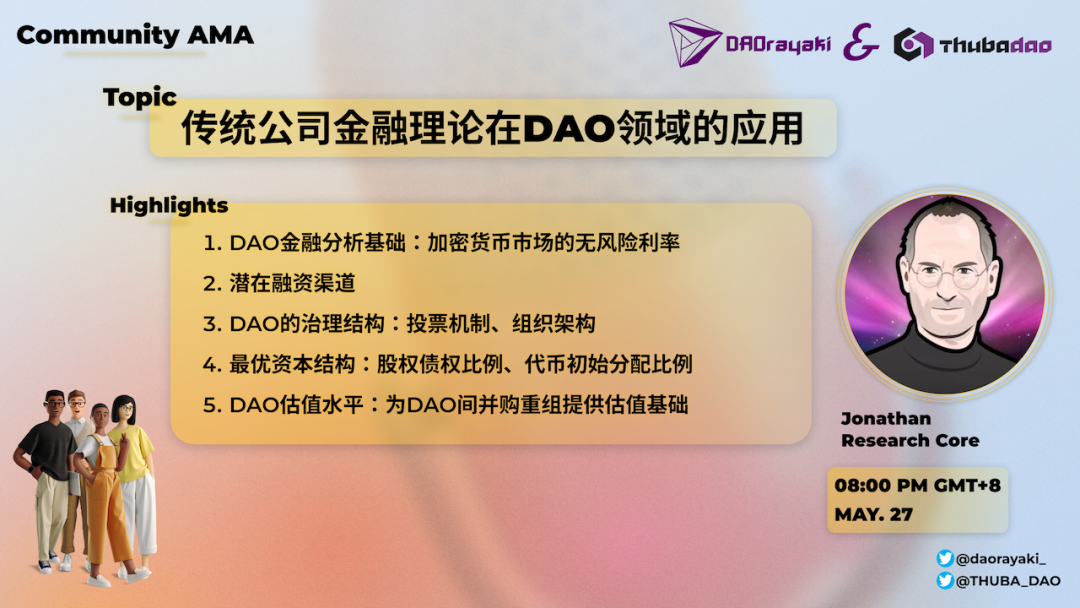
Definition of the current stage of DAO
Basic situation of DAO
Decentralized Autonomous Organization (DAO) generally refers to an organization that uses blockchain technology, conducts activities through smart contracts, and maintains the interests of all parties through a well-designed token economy. Participants are connected by common goals and collaborate through networks. Unlike the hierarchical structure design of traditional corporate systems, DAOs do not have central nodes and hierarchical structures, and all decisions are made by DAO members through voting. Since the concept of DAO was first proposed in 2014, DAOs have grown rapidly and have now differentiated into multiple types, such as funding, investment, protocol, collection, media, and social DAOs.
According to DeepDAO data [1], as of April 7, 2023, there are 12,353 DAOs worldwide with assets of $25.3 billion. The top five DAOs are Optimism Collective, Arbitrum One, Uniswap, BitDAO, and Polygon, with a total of approximately $16.5 billion in assets and a CR5 of 65%. As of early January 2023, there were only 10,752 DAOs worldwide with $8.8 billion in assets, and the top five DAOs were Uniswap, BitDAO, ENS, Gnosis, and Wonderland, with a CR5 of approximately 63%. DAOs are still in the stage of rapid iteration in terms of organization quantity, asset scale, and competitive pattern.
Due to the imperfect organizational structure of DAOs, many organizations currently adopt a dual structure of company + DAO, with the company serving as the developer, operator, asset custodian, and owner of the underlying protocol of the DAO. A typical example is Uniswap Labs, which is responsible for the development of the underlying protocol of Uniswap, while Uniswap is an openly free DAO.

Figure 1 Brief history of DAO development
Basic framework of corporate finance and DAO finance research
DAO is considered to be a resource organization form that can be compared with the corporate system and the basic production unit of the future metaverse. Compared with companies with assets of tens of billions of dollars, the development of DAO still has a long way to go. The rapid growth of asset scale under the corporate system is partially due to the acceleration of business efficiency through capital operation such as equity and debt financing, mergers and acquisitions, and restructuring. The expansion of high-quality DAO asset scale in the future requires equity and debt financing, and poor DAOs may face bankruptcy restructuring, debt restructuring, and other issues.
A simple framework of traditional corporate finance theory starts with an analysis of① the market risk-free rate, followed by an analysis of② potential financing channels (including primary PE/VC/IPO and secondary stock issuance/bond issuance),③ internal governance structure of the company, and④ optimal capital structure (the proportion of equity and debt under the MM theorem), to calculate⑤ the company’s valuation level (DCF/PE/PS and other methods), providing a valuation basis for further analysis of⑥ mergers and reorganizations between companies. The development of basic corporate finance theory is relatively mature. The goal of corporate governance is to maximize shareholder interests, rather than company interests or creditor interests.
Although there are significant differences from the corporate structure, the research framework of traditional corporate finance can also be applied to DAO, providing theoretical reference for DAO governance and future capital operations. Analogous to corporate finance, the basic framework of DAO finance analysis is to start from① the risk-free rate of the cryptocurrency market (although this rate may not exist), analyze② potential financing channels, internal governance structure of③ DAO (voting mechanism, organizational structure),④ optimal capital structure (proportion of equity and debt, initial token allocation ratio), and calculate⑤ the DAO valuation level, providing a valuation basis for⑥ mergers and reorganizations between DAOs. In benchmarking corporate finance, the goal of DAO governance should be to maximize the interests of all token holders, but this conclusion has not yet reached market and academic consensus. Maximizing DAO asset size, maximizing the interests of governance token and utility token holders, and maximizing DAO valuation may also become DAO governance goals. The direction of market consensus remains to be seen. This article will take the maximization of the interests of all token holders as the starting point of DAO governance objectives and briefly discuss DAO finance from six aspects: risk-free rate, potential financing channels, governance structure, optimal capital structure, valuation level, and mergers and reorganizations.
Six financial dimensions of DAO research
The risk-free rate faced by DAO
The risk-free rate in financial markets is usually based on the yield of government bonds or stock indexes. Government bonds are guaranteed by the government to repay funds and are unlikely to default except in extreme circumstances such as war. The cryptocurrency market has no government guarantee, and market institutions always carry risks. For example, the world’s second-largest cryptocurrency exchange FTX went bankrupt rapidly within a week at the end of 2022; in addition, there are risks such as account theft by hackers. Therefore, there is no completely risk-free rate in the cryptocurrency market. However, there is a low-risk rate as an opportunity cost of investing in the cryptocurrency market. Investors who invest “priced in BTC/ETH” and investors who invest “priced in US dollars or other fiat currencies” face two different opportunity costs. The former is usually a new cryptocurrency fund, and both fundraising and investment are done through BTC/ETH; the latter is usually traditional financial investment institutions and individual investors, who need to bear additional exchange rate risks of cryptocurrency and issuance.
Table 1 Compound Platform Lending and Borrowing Rates

Data source: Compound official website, as of April 7, 2023

Figure 2 Compound Platform ETH Lending and Borrowing Rates
For investors who value their investments in Bitcoin/Ethereum, the low-risk rate can be referenced by the borrowing and lending rates of DeFi. There are many cryptocurrency exchanges and institutions that provide decentralized finance (DeFi) lending, and due to differences in transaction costs and liquidity, there are often differences in prices for the same currency between different exchanges. This article uses the Compound project, which has a top-tier liquidity in the industry, to introduce low-risk rates. First, the deposit and loan mechanism of Compound is briefly introduced. Compound sets up a separate fund pool for each type of lending and borrowing asset. When a depositor deposits 1 ETH, the Compound platform issues 10 Compound tokens as a deposit certificate (exchange rate of 0.1). Assuming that the exchange rate rises to 0.12 when the user redeems, the user can receive 1.2 ETH, corresponding to a 20% profit. Borrowers need to pledge certain assets to borrow, such as pledging 1 Bitcoin can borrow the equivalent of 0.75 Ethereum (pledge rate of 0.75).
The pledge rate usually ranges from 0 to 0.75. When the price of the pledged assets fluctuates too much, the borrower will be required to add funds, otherwise it will be closed out. This mechanism to some extent guarantees the safety of the depositor’s funds. It is worth noting that Compound’s low-risk rate is not fixed, but is determined by the supply and demand of funds. Taking ETH as an example: the deposit rate is between 0% and 12.75%, and the loan rate is between 0% and 16.18% [2]. Compared with the risk-free rate of traditional finance (usually between 2% and 10%), the low-risk rate of cryptocurrency has a larger range of fluctuations, which means that the valuation of cryptocurrency assets naturally has the characteristic of large fluctuations.
For investors who calculate investment returns based on the US dollar, their low-risk rates can be the US Treasury bond yields in traditional financial markets, the collateral ETF index in the cryptocurrency market, and the arbitrage rate for simultaneously buying and selling cryptocurrencies. The method of using US Treasury bond yields does not apply to certain targeted funds in the cryptocurrency field, and LPs are unlikely to agree; the collateral ETF index in the cryptocurrency market is the most ideal method, but considering that the number of tradable cryptocurrency ETFs is very small, it is currently not applicable, and the validity of this indicator is expected to improve in the future; the arbitrage rate includes spatial arbitrage across exchanges and temporal arbitrage between futures and spot markets. It requires a large capital capacity for the hedging strategy, and the rate of return must be stable, otherwise it cannot be used as a general rate.
1. Cross-exchange arbitrage refers to the large price difference between different exchanges. Taking Bitcoin as an example, buying on exchange A and selling on exchange B can still generate positive returns even after considering transaction fees. For example, the daily trading price difference between the six major exchanges Bittrex and Exmo from 2015 to the end of 2022 is about 1%, and the highest is 13.65%, but it has decreased in recent years. That is, with the increase in liquidity, the prices of various exchanges tend to converge, and arbitrage opportunities disappear. 2. Spot-futures arbitrage refers to the use of the price difference between futures contract prices and spot prices for arbitrage. Investors can buy a certain amount of spot and sell the same amount of futures to obtain the price difference profit on the delivery date. If the exchange supports using the margin for buying spot to pay for the sold futures, low-risk arbitrage can be realized, otherwise there is a risk of forced liquidation due to insufficient margin when the price rises sharply. Both cross-exchange arbitrage and spot-futures arbitrage strategies have the problem of limited fund capacity and potential risks. The former has the risk of insufficient market liquidity and transaction failure due to insufficient trading speed, and the latter has a high risk of forced liquidation when it cannot pay the margin in spot. Therefore, for investors who use the US dollar as the pricing standard, a long-term effective low-risk interest rate still needs to be found.
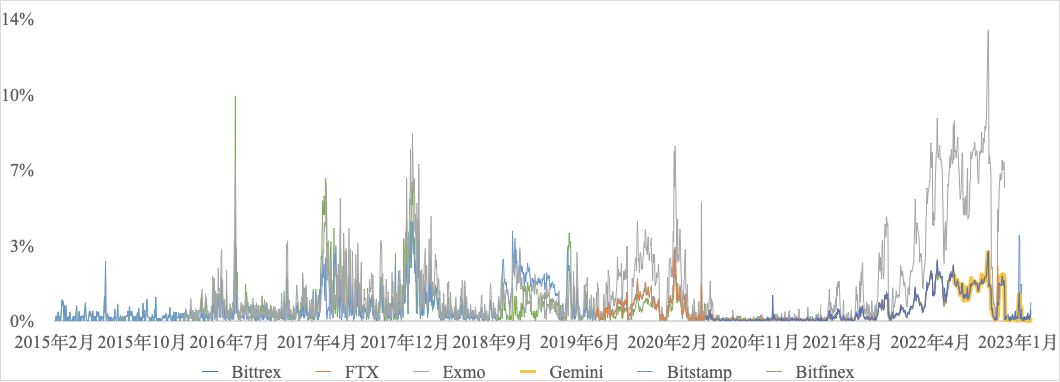
Figure 3 BTC price difference of major exchanges
Data source: Cryptodatadownload
Potential financing channels
Primary market: DAO obtains risk investment sources mainly including VC institutions denominated in traditional fiat currencies, VC institutions denominated in cryptocurrencies, and DAO funds denominated in cryptocurrencies. The top ten cryptocurrency funds before 2022 are all US-based funds. Except for Sequoia, which is a traditional VC, the others are newly established funds focusing on the cryptocurrency field. Only the funds of the head funds such as Blockingradigm and a16z have a fund size of more than US$2 billion, and the fund size of other funds such as Blockingntera and Sequoia is mostly less than US$1 billion. VC institutions denominated in traditional fiat/cryptocurrencies still adopt traditional VC structures, limited to high-net-worth individuals or high-risk-bearing populations in specific countries or regions. The investment goal is to obtain financial returns or strategic advantages. DAO funds refer to community members jointly raising funds or LP raising funds. Members initiate investment proposals and investment resolutions through governance tokens.
DAO funds currently mainly include three types: ① DAO venture capital funds raise funds through LPs, adopting a management fee + profit sharing model, which is more in line with the current legal framework; ② Syndicate DAO consists of Blockingrent DAO and sub-DAOs. Blockingrent DAO conducts due diligence, and sub-DAOs are established by Blockingrent DAO for each investment, generally with no more than 99 members. Sub-DAO members can receive investment returns and bear investment risks; ③ Service DAO provides consulting services to third-party funds in exchange for project equity or fixed service fees, but does not directly participate in investment decisions.
Table 2 Top 10 cryptocurrency funds before 2022
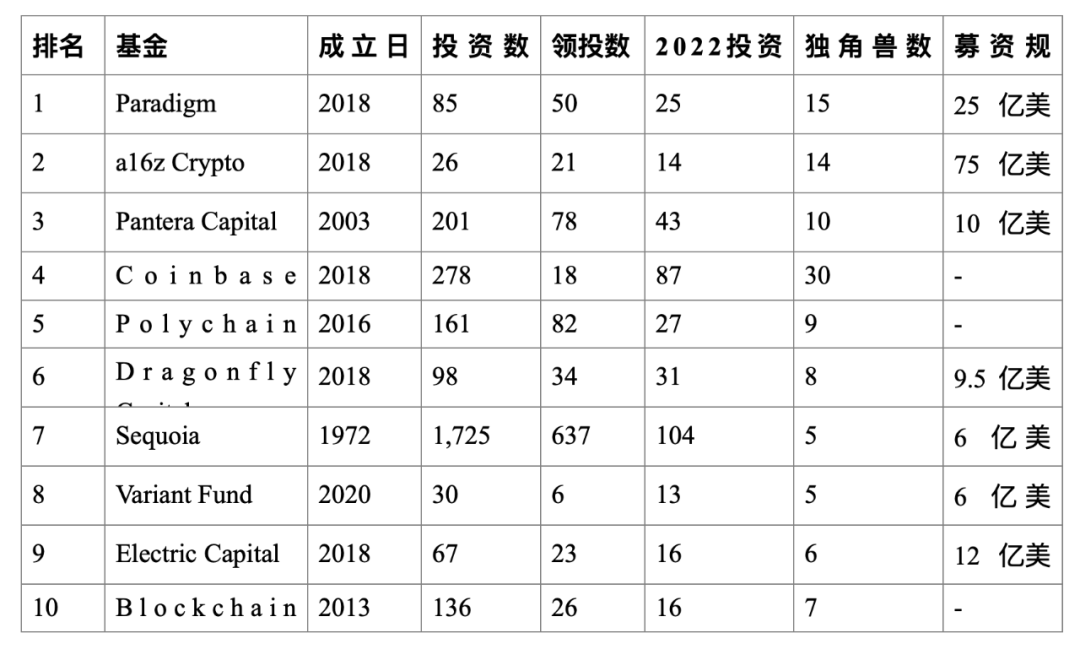
Source: Web3 VC Database
Primary Market: Another financing channel for DAOs in the primary market is the first coin offering ICO (Initial Crypto-Token Offering), which generally refers to the issuance of encrypted tokens by blockchain startups to raise general-purpose digital currencies such as Bitcoin and Ether. The issuance of tokens (tokens) can be used as payment tokens for platform-developed functions in the future, or exchanged for other cryptocurrencies on exchanges. There is no consensus method for valuing tokens in the industry. Some researchers propose to consider factors such as token liquidity, future unlocking time, and future supply-demand relationship to value them[5].
Compared with traditional IPO mode, ICO has obvious differences in issuance subject, issuance object, and institutional service. ①IPO issuer is a mature enterprise that has established a relatively complete organizational framework, business model, and more complete historical financial data, and can only be a limited liability company after equity reform. ICO is usually in the early stage of development of blockchain startups, and physical legal persons/non-corporate teams/individuals/DAO organizations can issue. Some projects can even conduct ICOs with only white papers and no actual products, such as Ethereum, which raised 18.4 million US dollars in Bitcoin in 42 days in 2014 with only a white paper. Most project token prices are less than 1 US dollar, and the fundraising scale is less than 500,000 US dollars.
②Compared with the limited liability company, the tokens issued by ICO may adopt two types of mechanisms: fixed total amount and unlimited upper limit. For example, the total amount of Bitcoin is only 21 million, while the total amount of Ether is unlimited. Taking Polygon as an example, its white paper stipulates that the total supply of the MATIC token is 10 billion, and the ICO sold 1.9 billion MATIC tokens in exchange for 5 million US dollars in BNB tokens. ③The stock of a limited liability company represents ownership, dividend rights, voting rights, and other rights, while blockchain startups may adopt a dual-token mechanism, that is, governance tokens have limited supply, investment value, and are similar to stocks, while game tokens have unlimited supply and are only generated and consumed within the platform. For specific discussions on the dual-token mechanism, please refer to Appendix One: Token Economic Model. ④ICO issuance has no mandatory intermediary institutions, although there are third-party institutions such as UD Blockchain that provide token issuance consulting services, but they are not mandatory, while IPOs must hire many intermediary institutions such as underwriters, accountants, and lawyers.
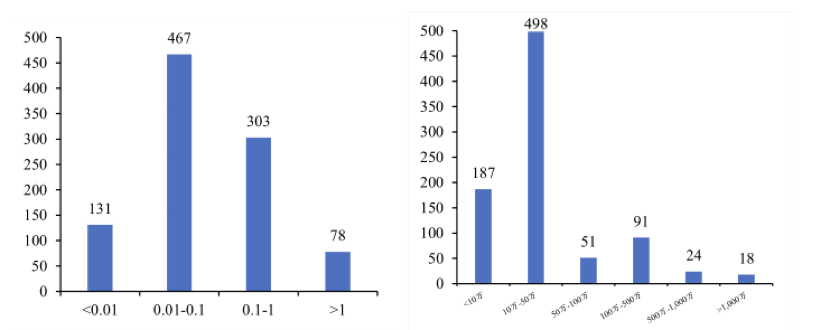
Figure 4 ICO Issuance Price (USD) from 2019 to 2022
Figure 5 ICO Fundraising Scale (USD) from 2019 to 2022
Data source: Coinmarketcap
Table 3 Top 10 Blockchain Tokens by Total Supply at the end of 2022
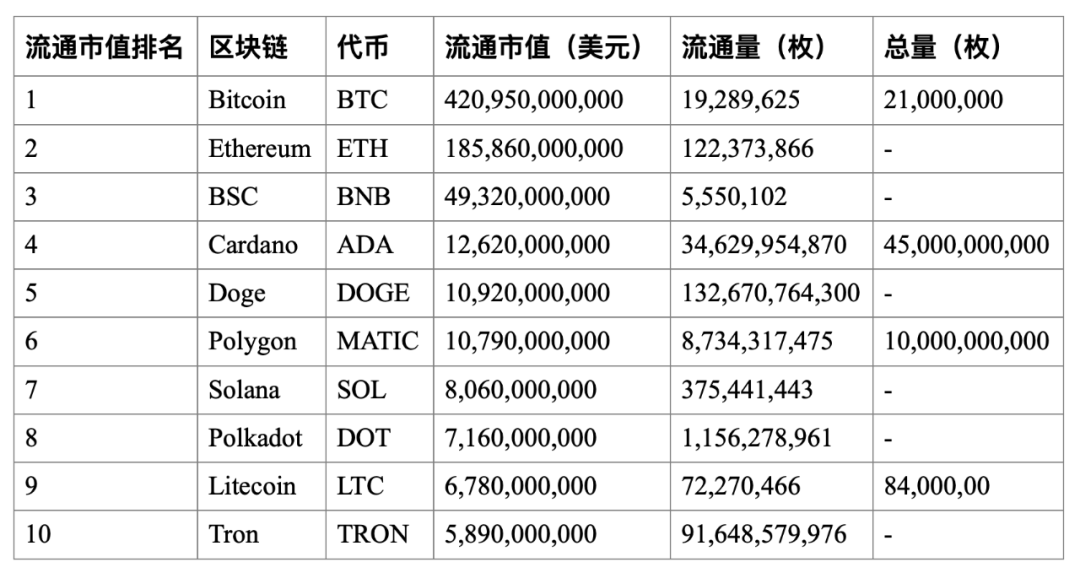
Data source: Coinmarketcap, as of December 31, 2022
Secondary Market: A joint-stock company can raise funds in the secondary market through stock issuance/bond issuance after listing, while DAO’s secondary market fundraising may be achieved through token sales or bond financing. The former means that DAO project parties usually only sell a portion of the tokens during the ICO and store the tokens required for future development in the treasury (the treasury concept is explained in Appendix I: Token Economic Model), so after a proposal is initiated and passed by the community vote, the tokens can be sold directly to the secondary market to quickly raise funds. Debt financing refers to DAO applying for short-term (less than 1 year) or long-term (several years) token loans from the loan market, or issuing bonds to obtain fiat currency loans from traditional capital markets. Due to factors such as the lack of long-term token loan products, DAO’s lack of legal entity qualifications to issue bonds, and the need to repay loans, and the fact that token financing does not require repayment, DAO’s secondary financing has not yet formed a significant volume. However, for DAOs with stable organizational structure and good future profit expectations, the cost of debt financing is far higher than that of token financing, so the scale of debt financing will continue to grow as the size of the DAO develops.
Token-based Governance Structure
The same voting rights and interests of joint-stock companies are mandatorily regulated by law, except for special AB share structures. One share represents one vote governance rights, and the one-share-one-vote model effectively protects the interests of shareholders. The tokens issued by DAOs do not naturally represent governance rights, only representing the right to use tokens to obtain the platform’s future development functions. The one-token-one-vote model is no longer applicable, and how governance rights are allocated is determined by each community’s own discussions.
Given the large number of community members, it is difficult for all community members to participate in voting and reach consensus, so some innovative governance allocation mechanisms have been proposed [6]. ①The quadratic voting mechanism allows a single voting subject to vote for the same option repeatedly, but the cost of voting is the square of the number of votes, which weakens the control of users with a large number of tokens, and enables projects supported by a large number of users to pass, typical applications are Gitcoin, but since fake identities will render the voting mechanism ineffective, social accounts need to be bound, which makes voting unable to achieve anonymity. ②Weighted voting and reputation voting link voting influence with holding period, lock-up period, avoiding the risk of massive borrowing funds to manipulate project voting, but a large amount of fund lock-up suppresses project liquidity, typical applications are Polkadot.
③Knowledge-extractable voting refers to the division of proposals into different themes, and different themes correspond to different knowledge tokens. Holders of certain knowledge tokens have higher weighting voting influence. This solves the investment problem in professional fields, but the reasonable allocation of knowledge tokens still needs to be studied. Typical applications are Dit protocol. ④Ragequit mechanism means that any member can withdraw the corresponding share of funds in the DAO and exit the DAO organization at any time. In theory, voting cannot harm the main interests of any member, but the organizational stability under this mechanism is limited. Typical applications are DAOhaus.
DAO governance mechanism design is still evolving, striving to find the optimal solution between voting efficiency and member consensus. The solution to the optimal DAO governance mechanism is no longer just a financial problem and needs to be further explored in practice, which will be a key factor in determining whether the size of DAO assets can increase exponentially.
Optimal Capital Structure
The purpose of planning the optimal capital structure is to maximize the value of DAO, focusing on the ratio of token and debt capital, and the distribution and release of tokens.
Under certain conditions, the tax-free MM theorem believes that the proportion of equity financing or debt financing adopted by an enterprise does not affect the total value of the enterprise, so it is impossible to increase the value of the enterprise by changing the capital structure. The tax-paying MM theorem believes that under certain conditions, the tax shield effect of debt financing increases the value of the enterprise, but the bankruptcy cost reduces the value of the enterprise accordingly, and the value of the enterprise increases first and then decreases with the increase of the proportion of debt financing. The MM theorem is expressed in the following formula:

The holding income of DAO tokens includes capital gains from the increase in token price and dividend rights corresponding to tokens. As long as the dividend rights of tokens are consistent with the principle of one share, one dividend for traditional stocks, the Modigliani-Miller Theorem can be applied to the DAO field. On the contrary, if the DAO dividend violates the principle of one share, one dividend, the Modigliani-Miller Theorem does not apply. However, since dividend behavior will cause tokens to be classified as securities, DAOs currently try to avoid dividend payments to token holders and instead benefit all parties through capital gains.
Overall, under the premise of one token, one dividend, the value of DAOs can be increased by appropriately increasing the proportion of debt, and the value increase mainly comes from the tax shield effect; the increase in the proportion of debt also leads to an increase in the capital cost of tokens.
The initial token distribution refers to the distribution of a fixed total amount of tokens among multiple parties, such as the founding team, marketing, investors, ICO, and the treasury, in a single-coin or dual-coin model. There is no unified view on the basic principles of token allocation and release, but two basic viewpoints can be summarized through numerical simulation: ① the token release cycle should match the user growth cycle; ② the treasury should hold more tokens to stabilize token price fluctuations.

Figure 6 Token Inflation Simulation Calculation Table
DAO Valuation Method
Yash Agarwal once proposed a framework for valuing DAO communities [7], analyzing the indicators and dimensions that DAO valuations should focus on, but did not propose a quantitative model method. Kristof Lommers once proposed a preliminary quantitative approach to DAO token valuation [5]. The valuation method is divided into relative valuation and absolute valuation. Relative valuation refers to benchmarking DAOs based on certain indicators and recognized valuations, thereby obtaining the valuation of the target DAO. Kristof initially proposed that TVL, protocol trading volume, token trading volume and speed, and user net present value can be used as benchmark indicators for relative valuation, but due to the scarcity of DAOs with stable and recognized valuations, the application scenarios of relative valuation are currently limited.
In terms of absolute valuation, Kristof proposed that the value of DAO tokens can be divided into the expected cash flow discounted value of tokens, the implicit value discounted value of governance rights, and the expected discounted value of pledging rewards. This method essentially considers that the value of tokens equals the capital gains, governance benefits, dividends, and pledge benefits that holding tokens can obtain. Among them, governance benefits are difficult to measure and holders of different amounts of tokens enjoy different governance benefits, so different holders will get different valuation results.
Kristof’s absolute valuation method has important reference significance for token investment pricing, but it is not entirely applicable to the DAO M&A and restructuring scenario. The valuation of DAO M&A should be based on all voting tokens, which are neither all circulating tokens nor all tokens. The main point is that as long as one DAO controls all voting tokens, it can grasp the full control of another DAO. Therefore, the DAO valuation is equal to the total number of voting token * token valuation.
Key points of DAO M&A restructuring
From the stage of savage growth to ordered growth, small DAOs with poor management can achieve asset revitalization through bankruptcy liquidation, while large DAOs with poor management may achieve it through acquisition. Well-run DAOs may also achieve rapid growth through M&A restructuring. On December 8, 2021, the proposal for the merger of xDai and Gnosis was approved, and 1 xDai token STAKE was exchanged for 0.032 Gnosis tokens GNO. xDai Chain was renamed Gnosis Chain [8]. On December 22 of the same year, the merger proposal between Rari Capital and Fei Protocol was approved by the members of both DAOs, and Rari token RGT was converted to TRIBE [9], with a total lock-up value of 2 billion US dollars after the merger. The merger agreement stipulates that RGT token holders can exchange RGT for TRIBE at a ratio of 1:26.7 (RGT:TRIBE) within 180 days; those who do not agree with the merger can exchange a certain share of Fei Protocol’s fund pool for TRIBE within 3 days.
During the M&A restructuring phase, attention should be paid to two aspects: organizational structure integration and transaction consideration. In terms of organizational structure integration, if the M&A target organizational structure is the same and belongs to the same public chain, the technical difficulty of the merger is limited, and how to avoid KOL loss caused by the merger is the key issue; if the organizational structure is not the same, it is necessary to depend on the operating conditions and future development strategies of both parties to determine whether to adopt a new structure or integrate one into the other, and no matter which method is used, the difficulty is much higher than the former; if the two merging parties belong to different public chains, there are currently limited reference cases, but there is logical feasibility, which needs to be observed in the future. In terms of transaction consideration, logically, there are several types of payment methods, such as cash and equivalent payment, token exchange payment, debt loan payment, and several types of payment methods. Considering the operational difficulty, token exchange payment will still be the mainstream method in the short term. The token exchange payment ratio can be determined by the valuation method mentioned in (5) DAO valuation method.
Reference
[1]DeepDAO https://deepdao.io/organization/10edb97a-9dba-448a-88b1-ca263a7c75ad/organization_data/finance.
[2]ETH Interest Rate Model https://compound.finance/markets/ETH.
[3]Cryptodatadownload https://www.cryptodatadownload.com/data/.
[4]Web3 VC Database https://codygarrison.notion.site/Web3-VC-Database-2022-de9c391f8dd14a8a9a3e01a69f4e0b7f.
[5]A Framework for DAO Token Valuationhttps://mirror.xyz/kristoflommers.eth/koszUqhfZ83GN5_UuxIo7orjSmRB1lBRL24EWMYfJ64.
[6]7 common voting mechanisms for DAOs https://www.panewslab.com/zh/articledetails/1642043584042534.html.
[7]How to value a community? — DAO Valuation Frameworks https://yashhsm.medium.com/how-to-value-a-community-dao-valuation-frameworks-7a5e80e3e11d.
[8]xDai / Gnosis Merger AMA https://docs.gnosischain.com/updates/archive/2021/xdai-gnosis-merger-ama/.
[9]DAO mergers: the future of M&A? https://www.gtlaw.com.au/knowledge/dao-mergers-future-ma.
[10]Tokenization and Token Economic Solutions https://www.ud.hk/sc/blockchain-solution-tokenization-tokenomics-ico-ido-ieo-sto.
[11]Comparison of Single Coin and Dual Coin Models https://foresightnews.pro/article/detail/13933.
We will continue to update Blocking; if you have any questions or suggestions, please contact us!
Was this article helpful?
93 out of 132 found this helpful
Related articles
- Resolution to the US debt crisis and inflation
- Summary of evidence related to the SEC’s lawsuit against Binance
- Application of Traditional Corporate Finance Theory in the DAO Field
- Latest developments in SEC’s “Operation Thunder”: Coinbase refuses to take down tokens and services, while Binance retaliates by actively seeking Gensler’s advice as a consultant.
- Four narrative shifts in the Ethereum ecosystem’s cycles
- Understanding Binance’s Decentralized Global Operating Model from SEC Lawsuit Documents
- 5 Misconceptions About the Metaverse



